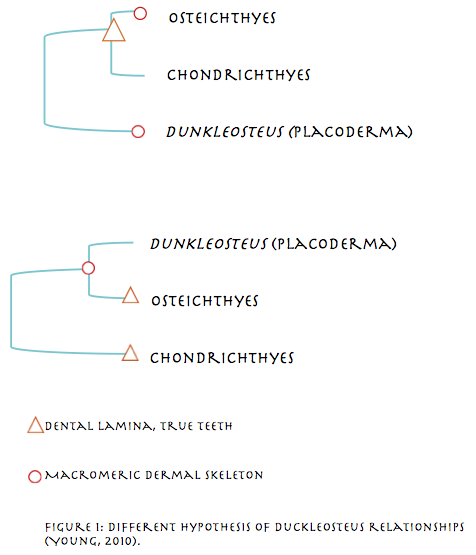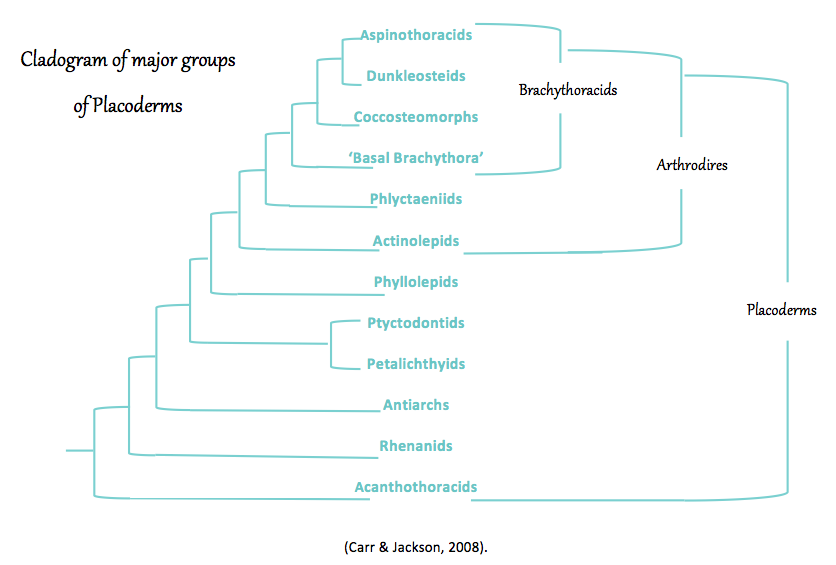Classification
Domain: Eukarya
Kingdom: Aminalia
Phylum: Chordata
Class: Placodermi
Order: Arthrodira
Family: Dunkleosteidae
Genus: Dunkleosteus
(Dunkle's Bones)
Species: Dunkleosteus terrelli
(Blunt Spear)
Figure 1. Different hypothesis of
Dunkleosteus Relationships (Young, 2010).
Domain/Kingdom:
Dunkleosteus terrelli is included in the domain Eukarya and the kingdom Animalia. They are included in these taxonomic levels because this organism is a multicellular organism plus contain eukaryotic cells. Eukaryotes have cells that contain membrane bound organelles and also have a true nucleolus. Furthermore, organisms in the domain eukarya use mitosis and meiosis for the division of their cells, whether it be for reproduction or for reconstruction, growth and development. Eukaryotes also contain mitochondria for the process of cellular respiration which is a process that prokaryotes do not partake in. D. terrelli is in the kingdom Animalia because it is a vertebrate (Floglia, 2010).
Phylum:
Dunkleosteus terrelli is in the phylum chordata. This prehistoric fish is a part of this phylum because it is an organism that contains an endoskeleton. Along with the endoskeleton Chordates also have a backbone. Since Dunkleosteus terrelli is a type of fish, then it would be classified the same as a fish of today would. We can relate this organism to the more well known bull shark or sea otter that still exist today. The two organisms previously listed are also chordates because they share the same characteristics as Dunkleosteus terrelli. Organisms in the phylum chordata have a vertebrae, a nerve cord, a closed circulatory system and a brain, which are all aspects that are necessary for theis phylum (Palaeos, 2009).
Class:
Placoderma is a class of extinct vertebrates fishes. Dunkleosteus terrelli is part of this class because they lived about four hundred million years ago. We can relate placoderms to other placoderms of this time. Refer to the cladogram below for other organisms in the class placoderma. These organisms are labeled as armored fish that have extremely powerful jaws. This is the main reason Dunkleosteus terrelli is in this class. Also because they have long bodies with shark like tales to help them swim. Every organisms in the class placodermi have no teeth and in replacement of those teeth, have bony plates to help them destroy their food (Palaeso, 2009).

Figure 3. Cladogram of major groups or placoderms. D. terreilli is included in the order Arthrodires and the family dunkleosteids (Carr & Jackson, 2008).
Order:
Arthrodaria means jointed neck. Meaning that there are different joints in the neck allowing for a powerful jaw and head. These unique fish have a head of armor that is also found on other parts of their body (Palaeos, 2009).
Family:
Extinct family of vertebrates (see class: placoderms) with a jointed neck ( see order: arthrodaria).
Genus/Species:
Dunkleosteus terrelli is a prehistoric fish living in the Late Devonian period. This fish was a fierce predator that other fish stood no chance against.
To learn more about different classifications of Eukaryotes visit this educational website.
To learn more about the adaptations Dunkleosteus terrelli established refer to our form and function page.